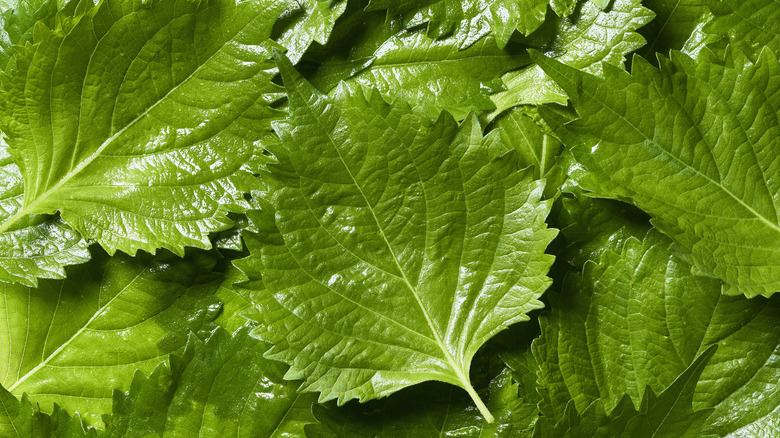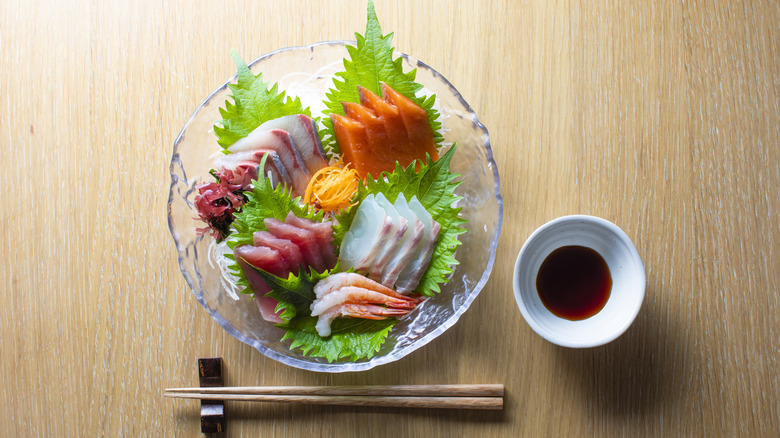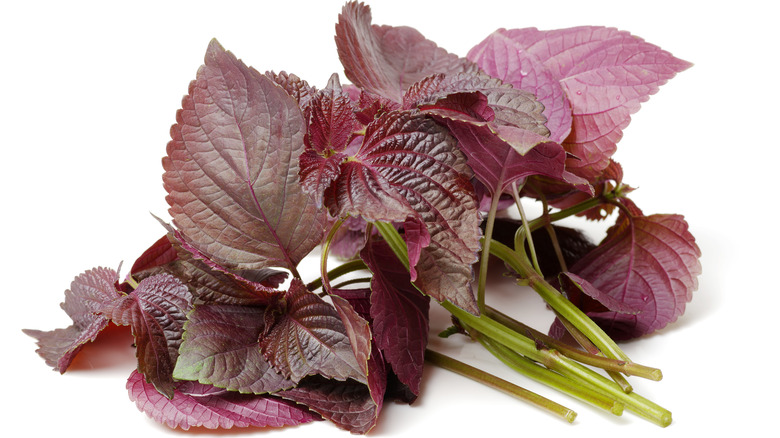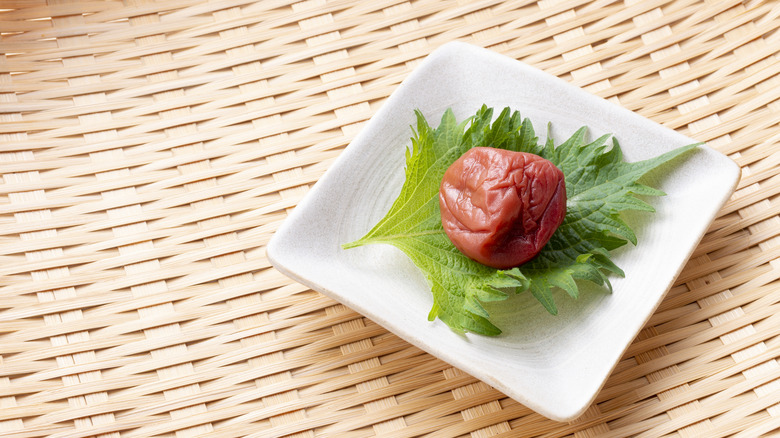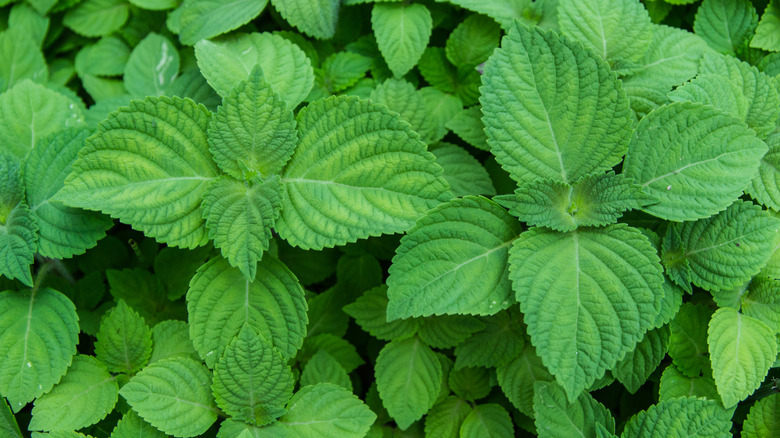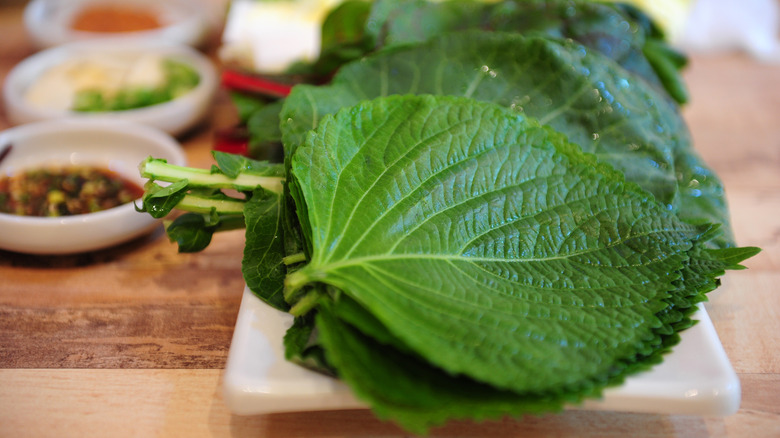What Is Shiso And How Is It Used?
If you've ever picked up a pack of sushi or a bento box from a store, you may have noticed grass-like leaves made from plastic separating the different components of your meal. In reality, these are knock-off dupes meant to imitate the real deal, which are shiso leaves that often accompany the gari, wasabi, and soy sauce that come with sushi and sashimi.
Shiso is a heart-shaped aromatic herb with jagged saw-toothed edges that goes by many names: It is also known as oba, which means big leaf in Japan — and is famous under its Latin name, Perilla, which was used to introduce the leaf to the West in the mid-1800s. Botanically classified as Perilla frutescens var. crispa, one may also know shiso as the beefsteak plant or by its unofficial moniker of Japanese mint, which it gets from its flavor and close relation to the mint and basil family of plants. Regardless of the name with which you may associate this leaf, shiso is a popular ingredient in Japan and across Asia as a whole where it is used for its crunchy texture, unique flavor profile, and the many health benefits associated with it.
What is shiso?
While shiso is a staple in Japanese cuisine, the leaves happen to be Chinese in origin. Much like Buddhism, silk, and green tea, shiso was also introduced to Japan — though perhaps later than the others, in the eighth or ninth centuries through a flourishing trade exchange with Chinese merchants. While shiso leaves are used in all kinds of food and drink preparations these days, it wasn't the leaves that were originally introduced to Japan. Rather, it was the seeds of the shiso plant that were prized commodities and traded for their ability to light lamps when turned into oil.
Sometime along the way, the leaves were discovered, and they began to be paired with raw fish and seafood. There is an antibacterial compound — phytoncides — present in shiso leaves. Normally, phytoncides help the plant fight off disease and infection thanks to their antifungal and antibacterial nature (per the Department of Environmental Conservation of New York). Phytoncides can slow the rate at which raw fish and seafood spoil since the leaves have antiseptic properties, and they can even fight any food poisoning caused by raw seafood, which made shiso indispensable in early Japanese sushi-making. This may be why sashimi slices often come wrapped in shiso — and why the leaves are used to separate different (and often raw) components in a bento box or a sushi platter.
Different varieties of shiso and what they taste like
There are two main varieties of shiso leaves: one that's green in color and the other that has a red or reddish-purple hue. While both red and green shiso have astringency and bitterness to them, the leaves differ in terms of their overall flavour which subsequently affects how they are cooked and eaten.
Green shiso or aojiso, with its bitter yet menthol-y taste, is more reminiscent of the family of mint plants that it comes from and has notes of lemon as well as cinnamon and anise. Green shiso leaves a subtle sweet aftertaste on the tongue and is generally thought to be milder in flavor with a smoother fragrance and a softer texture than the other variety.
On the flip side, red shiso or akajiso has a harsher fragrance, a tougher texture, and is found to be considerably more bitter due to the anthocyanin compound present in it, the same compound that gives the leaf its reddish-purple color. While some tend to be less sensitive to this bitter compound than others, akajiso is nevertheless mostly used for its striking color that works as a natural dye in foods rather than its flavor. Red shiso is the secret to the rich red-colored tinge of Japanese pickled plums or umeboshi and it is the key ingredient in the vividly pink shiso juice.
How to cook with shiso?
Depending on the variety of shiso, the leaves can be cooked in several different ways. Red shiso leaves are salted and added to yellow Japanese plums to make pickled umeboshi, or they can be simmered with sugar, water, and vinegar to make fruity shiso juice. The brine leftover from red shiso-stained umeboshi is also used to make beni shoga or Japanese pickled ginger that often goes on top of okonomiyaki and donburi as a garnish.
While red shiso is mostly used for pickling and coloring foods, green shiso is used for practically everything else. Much like its cousins basil and mint, green shiso can be added to salads for a touch of lemony flavor or served over a hot bowl of ramen and fried rice. The flavor of green shiso goes marvelously with fatty varieties of fish such as salmon and tuna. Green shiso can be fried into crisp tempura, rolled inside Vietnamese spring rolls, or even used to make icy granitas and refreshing beverages.
A popular way to eat shiso in Japan is to roll the leaves around a sweet filling of miso, nuts, and vegetables like eggplants, and fry the skewered rolls into a crisp snack. When in doubt, however, you can always think of green shiso as a garnish and add it to things like omelets and soups as you would dried seaweed. The only thing to be careful of is that large shiso leaves can have a very fibrous texture, so it's best to cut them into chewable strips first.
Where to buy shiso and how to store it?
As shiso is a very popular ingredient in Japan, it should be easy to find at Asian supermarkets or specialty shops selling Japanese groceries. Fresh shiso leaves are typically kept alongside other fresh herbs, and if you manage to snag a bunch of these, it's best to wrap unwashed leaves in wet paper towels or airtight plastic bags and store them in a refrigerator. Ideally, you should store them in the crisper drawer and use them within four days of purchase.
Green shiso leaves are usually available all year round whereas red ones are in season in the early months of summer, but some stores also sell frozen shiso flavored with sesame oil or mix shiso with ume fruits in a tube. Red shiso may also be available in a dried and ground form as yukari, which is a furikake (a Japanese condiment) that is used to season rice, soups, fish, and salads.
If you can't find a steady supply of shiso, you can always grow your own leaves. It's very easy to grow shiso even in the small confines of a home garden – all it needs is sun, well-draining soil, and regular pruning. Two weeks after planting, you should have the first batch of homegrown shiso leaves ready for harvest.
Nutritional information about shiso
The first ever mention of shiso was made in an 1110 BC book from the Song Dynasty called "Taiping Huimin Hejiju Fang" or "Recipes to Benefit the People from the Pharmaceutical Bureau of the Taiping Reign" where it was used as a medicinal ingredient. Shiso has a long history of use in the traditional Chinese medicinal system where the leaves were used to treat morning sickness, congestion, and the common cough. Named zisu after the words for purple (zi) and comfort (su) in China, shiso is thought to help with food poisoning and colds as well.
Shiso is an excellent source of nutrients such as vitamin A, vitamin C, and vitamin K, and it is packed with significant levels of antioxidants. According to a 2012 study published by the Avicenna Journal of Phytomedicine, the polyphenols in shiso are rich in flavonoids. Additionally, the flavonoids can help combat chronic disease-causing-free radicals, promote skin health, and manage cellular activity in the body (per Healthline). This is why, while shiso is a staple in many cuisines, the leaves are also simply steeped in hot water and drunk as a medicinal tea to make the most of all the health benefits packed in them.

